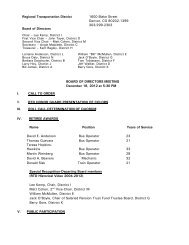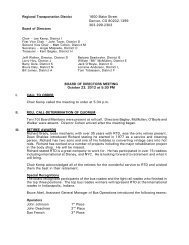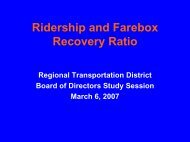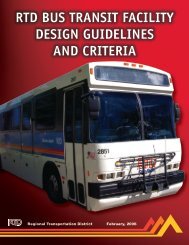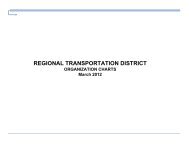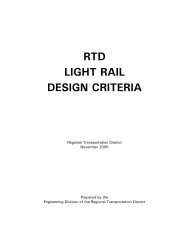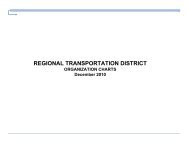Commuter Rail AC Electrification Load-Flow Simulation Report - RTD
Commuter Rail AC Electrification Load-Flow Simulation Report - RTD
Commuter Rail AC Electrification Load-Flow Simulation Report - RTD
You also want an ePaper? Increase the reach of your titles
YUMPU automatically turns print PDFs into web optimized ePapers that Google loves.
<strong>Commuter</strong> <strong>Rail</strong> <strong>AC</strong> <strong>Electrification</strong> <strong>Load</strong>-<strong>Flow</strong> <strong>Simulation</strong> <strong>Report</strong> Revision 1<br />
the bus-tie circuit breakers to close only when one of the buses is deenergized (the busbar<br />
voltage is monitored by potential transformers) and the associated circuit breaker feeding the<br />
deenergized busbar is open. The interlocking prevents the bus-tie circuit breakers to close<br />
when both buses are energized.<br />
10.0 CONCLUSIONS AND RECOMMENDATIONS<br />
The load-flow simulation results show that the studied traction electrification system design of<br />
the three <strong>Commuter</strong> <strong>Rail</strong> Corridors, East Corridor, Gold Line, and North Metro Corridor is in<br />
compliance with the <strong>RTD</strong> Design Criteria and accepted industry practices, specifically:<br />
• Train voltages are well above the minimum design values for normal and contingency<br />
operations.<br />
• Change in substation, paralleling station, and switching station locations may be made<br />
for operational requirements and due to real estate availability. Changes in facility<br />
locations will not materially impact the minimum system voltages.<br />
• Substation and autotransformer ratings were selected to enable the system to operate<br />
during normal and contingency situations.<br />
• Catenary and feeder currents are well below the overhead feeder and catenary system<br />
conductor thermal capabilities.<br />
Since the autotransformer-fed system performed with a significant operational margin,<br />
consideration should be given to the utilization of 1x25 kV direct-fed system. Preliminary results<br />
indicate that the 1x25 kV system might be effective but more comprehensive simulations would<br />
be required to ensure its viability. It is believed that this alternative system would be much<br />
simpler, substantially less expensive to build and maintain, and provide more efficient utilization<br />
of equipment.<br />
Regardless of whether an autotransformer-fed system or direct-fed system is selected for<br />
implementation, it is recommended that a utility impact study be performed. A key element of<br />
the study should be investigation into the effects of the highly fluctuating traction power load on<br />
the transmission system including a voltage flicker study. The unbalanced nature of the load<br />
due to phase-to-phase substation transformer connections should be evaluated and the levels<br />
of negative sequence currents in nearby generators determined. Further, the study should<br />
evaluate the effects of harmonics on total and individual harmonic distortion of voltages and<br />
currents and assess the likelihood of utility system resonance.<br />
02/27/2009 FRSC Page 36 of 250




